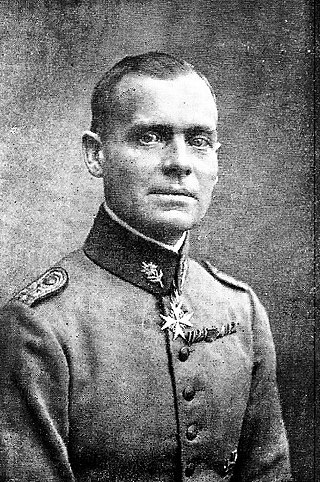
Franz Friedrich Böhme was an Army officer who served in succession with the Austro-Hungarian Army, the Austrian Army and the German Wehrmacht. He rose to the rank of general during World War II, serving as Commander of the XVIII Mountain Corps, Hitler's Plenipotentiary Commanding General in the Balkans, and commander-in-chief in German-occupied Norway during World War II. After the war, Böhme was transferred to U.S. custody as a defendant in the Hostages Trial on charges of having massacred thousands of Serbian civilians. He committed suicide in prison.

Robert Martinek was an Austrian general who served in the Wehrmacht of Nazi Germany during World War II. He was a recipient of the Knight's Cross of the Iron Cross with Oak Leaves.

Adolf Kurt Ernst Strauß was a German officer who served in the Prussian Army, the Imperial German Army, the Reichswehr, and later as a general in the Heer of Nazi Germany's Wehrmacht during World War II.

Heinrich Kirchheim was a German generalleutnant who served in both World War I and World War II. He is also one of few German officers who were awarded the Pour le Mérite and the Knight's Cross of the Iron Cross. He also served as a deputy member on the "Court of Military Honour," a drumhead court-martial that expelled many of the officers involved in the 20 July Plot from the Army before handing them over to the People's Court.
Hermann Flörke was a German general during World War II who commanded the 14th Infantry Division. He was a recipient of the Knight's Cross of the Iron Cross with Oak Leaves.
Werner von Bercken was a general in the Wehrmacht of Nazi Germany during World War II who commanded several divisions. He was a recipient of the Knight's Cross of the Iron Cross. Bercken surrendered to the Red Army on 28 April 1945 in the Vistula Spit. Convicted as a war criminal in the Soviet Union, he was held until 10 October 1955.

Georg von Bismarck was a German general during World War II who commanded several divisions. He was a recipient of the Knight's Cross of the Iron Cross of Nazi Germany.
Ernst Sieler was a general in the Wehrmacht of Nazi Germany during World War II who commanded the LIX. Corps. He was a recipient of the Knight's Cross of the Iron Cross with Oak Leaves. Sieler surrendered to the Soviet forces in the course of Red Army's Vistula–Oder Offensive. He was held in the Soviet Union as a war criminal until 1955.

Wilhelm Hasse was a general in the Wehrmacht of Nazi Germany during World War II who commanded the 17th Army. He was a recipient of the Knight's Cross of the Iron Cross with Oak Leaves. Hasse died on 21 May 1945 of wounds sustained earlier that month.
Kurt von der Chevallerie was a German general in the Wehrmacht during World War II who commanded the German 1st Army. He was a recipient of the Knight's Cross of the Iron Cross with Oak Leaves. Chevallerie retired from the Army on 31 January 1945. Despite his retirement, von der Chavallerie disappeared during the Soviet invasion of East Prussia and Pomerania and is listed missing in action near Kolberg since 18 April 1945.
Anton Grasser was a German general during World War II who commanded several corps. He was a recipient of the Knight's Cross of the Iron Cross with Oak Leaves. Grasser joined the Bundesgrenzschutz in 1951, retiring in 1953.
Friedrich Mieth was a German general during World War II. In 1942, he commanded Army Group Don Rear Area. Mieth was killed in action on 2 September 1944 in Iași, Romania.
Wilhelm Berthold Helmuth Beukemann was a general in the Wehrmacht of Nazi Germany during World War II. He was a recipient of the Knight's Cross of the Iron Cross.
Rolf Fritz Carl Max Willy Wuthmann was a German general in the Wehrmacht during World War II who commanded the IX Army Corps. He was a recipient of the Knight's Cross of the Iron Cross.
Johann Paul Friedrich Drekmann was a German officer, a Diplom-Ingenieur and a highly decorated Generalleutnant in the Wehrmacht during World War II. He was also a recipient of the Knight's Cross of the Iron Cross. The Knight's Cross of the Iron Cross was awarded to recognise extreme battlefield bravery or successful military leadership. Paul Drekmann was captured by British troops in May 1945 and was held until 1947.
Stefan Fröhlich was an Austrian officer and German general during World War II. He was a recipient of the Knight's Cross of the Iron Cross of Nazi Germany.

Curt von Jesser was an Austrian general in the Wehrmacht of Nazi Germany during World War II. He was a recipient of the Knight's Cross of the Iron Cross.
Heino von Rantzau was a highly decorated Generalleutnant in the Luftwaffe during World War II. He was also a recipient of the Knight's Cross of the Iron Cross. Heino von Rantzau was captured by American troops in April 1945, and died in captivity on 2 November 1946.

Otto Stapf was a German general during World War II who commanded the 111th Infantry Division and the XXXXIV. Army Corps and led the Economic Staff East. He was the only recipient of both the Knight's Cross of the Iron Cross and the Knight's Cross of the War Merit Cross with Swords of Nazi Germany.
August Wittmann was a general in the Wehrmacht during World War II. He was a recipient of the Knight's Cross of the Iron Cross.







